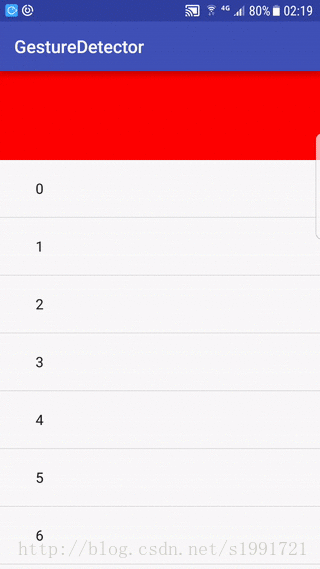您好,登錄后才能下訂單哦!
您好,登錄后才能下訂單哦!
這篇文章主要介紹Android如何根據手勢實現頂部View自動展示與隱藏效果,文中介紹的非常詳細,具有一定的參考價值,感興趣的小伙伴們一定要看完!
首先來看一下效果:

大體思路如下:
總體布局用了一個自定義的ViewGroup,里面包了兩個View(top View,bottomView)
我在bottomView里放了ViewPager,里面又有Fragment,Fragment里放的是ListView
原理:
ViewGroup在分發touchEvent的時候先通過手勢GestureDetector判斷手勢方向,當向上滑動的時候讓topView和bottomView同時向上移動,反之亦然。
整體思路不是很難如下是干貨:
布局文件
<com.lin.gesturedetector.MyViewGroup android:id="@+id/view_group" android:layout_width="match_parent" android:layout_height="match_parent"> <include android:id="@+id/group_top" layout="@layout/view_top" /> <include android:id="@+id/group_bottom" layout="@layout/view_bottom" /> </com.lin.gesturedetector.MyViewGroup>
手勢監聽重要的是打log看一下上下滑動是數值的變化,找到其規律:
@Override
public boolean onScroll(MotionEvent e1, MotionEvent e2, float distanceX, float distanceY) {
Log.i(tag, "onScroll -> distanceY" + distanceY);
if (distanceY < 0) {// 手勢向下滑動是負值
animatorLayoutOffset(1);
}
if (distanceY > 0) {
animatorLayoutOffset(0f);
}
return true;
}一定記得在ViewGroup內查找控件需要在onFinishInflate后才能找到:
@Override
protected void onFinishInflate() {
super.onFinishInflate();
viewTop = findViewById(R.id.group_top);
viewBottom = findViewById(R.id.group_bottom);
}在ViewGroup布局的邏輯中需要處理的有一下幾點:
1、onMeasure的時候要把子控件測量出來
2、onLayout時需要手動將子控件布局
接下來就是監聽手勢設置動畫,不停的onLayout以達到topView和bottomView的布局效果
@Override
protected void onMeasure(int widthMeasureSpec, int heightMeasureSpec) {
int width = MeasureSpec.getSize(widthMeasureSpec);
int height = MeasureSpec.getSize(heightMeasureSpec);
viewTop.measure(MeasureSpec.makeMeasureSpec(width, MeasureSpec.EXACTLY), MeasureSpec.makeMeasureSpec(height, MeasureSpec.AT_MOST));
viewBottom.measure(MeasureSpec.makeMeasureSpec(width, MeasureSpec.EXACTLY), MeasureSpec.makeMeasureSpec(height, MeasureSpec.EXACTLY));
setMeasuredDimension(width, height);
}
@Override
protected void onLayout(boolean changed, int l, int t, int r, int b) {
int topHeight = viewTop.getMeasuredHeight();
float offset = layoutOffset * topHeight;
int width = r - l;
float topViewYTop = offset - topHeight;
float topViewYBottom = topViewYTop + topHeight;
viewTop.layout(0, (int) topViewYTop, width, (int) topViewYBottom);
viewBottom.layout(0, (int) topViewYBottom, width, (int) topViewYBottom + viewBottom.getMeasuredHeight());
}
private void animatorLayoutOffset(float offset) {
if (animator != null && animator.isRunning()) {
return;
}
animator = ObjectAnimator.ofFloat(this, "layoutOffset", layoutOffset, offset);
animator.setDuration(500);
animator.start();
}以上是“Android如何根據手勢實現頂部View自動展示與隱藏效果”這篇文章的所有內容,感謝各位的閱讀!希望分享的內容對大家有幫助,更多相關知識,歡迎關注億速云行業資訊頻道!
免責聲明:本站發布的內容(圖片、視頻和文字)以原創、轉載和分享為主,文章觀點不代表本網站立場,如果涉及侵權請聯系站長郵箱:is@yisu.com進行舉報,并提供相關證據,一經查實,將立刻刪除涉嫌侵權內容。